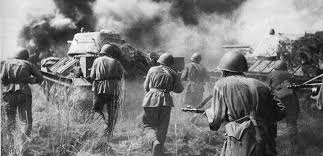Written By: Draga Ivić
On some portals we can see a separate topic called ”Eastern Front”, so we can often meet this syntax in the news.
Why did their editors choose to name the area where everything is taking place (as the Russians officially call it and represent it in the Security Council), i.e. occupation, aggression, etc., as the attacked side and its allies call it?
Their answer will be neither easy nor convincing. In terms of the manner of action and the conduct of operations (even in terms of the volume that is significantly larger than the recent local conflicts), we can certainly call this line of contact of the opposing sides a front.
The aim of this short text is to show what is the difference between that Eastern Front from the time of World War II and this one, today. Therefore, I am new and titled symbolically as "beta version”, i.e.” 2.0" in the spirit of modern marking.
However, if we remember history, we see that the ”godfathers” of this conflict are mistaken, because history inexorably proves the following: on that Eastern Front, Nazi Germany attacked the Soviet Union without declaring war. The "bad guys" (communists, Bolsheviks) were attacked by much worse guys – fascists and their allies.
According to the logic of the proponents of the thesis that this is an aggression, then this front should be called the Western Front given the initial direction of attack. However, on the generally known Western Front (in both wars) the ”good guys” fought the bad guys. Suffering with historical legacy.
However, for the sake of our readers, it would be good to explain a relatively simple phenomenon and answer the question – What is the front and how much this noun has meaning. By the way, what the world called the Eastern Front in World War II, the Soviets called the Western Front. It is not difficult to use logic.
The name front (first adopted in German military vocabulary) comes from the Latin word Frons (forehead). In general, the front of something. However, this interpretation does not end by accident. The front can be much more:
The side of the machine that faces the elder or the asset it serves.
The front of the fighting order facing the opponent, the operational position of Living Force and Means.
Arrangement of ships, aircraft and other techniques on a line that is at a right angle (perpendicular) with respect to their movement.
It can be both complex and assembled from multiple machines of ships and vessels.
General name and understanding of the territory on which war activities take place, the line of conflict with the opponent. It is believed that it can be up to 25 kilometers deep operationally, but now that distance has been significantly increased thanks to the range of the weapons.
A single, uninterrupted front is a large-length battle order (the true Eastern Front stretched from the USSR's extreme border with Norway, to the Black Sea), saturated with living force and means, as well as objects intended for their defense, without uncovered parts. Such fronts appeared in the First World War (the Western Front and the Salonika front, which in French military terminology is called the Eastern Front) and in the Second World War (the Eastern Front launched in 1941). the Western Front was launched in 1944. years). In this sense, the front received the highest geostrategic name. The other battle lines were significantly shorter, so they cannot be ranked as fronts in this sense.
The front is also called the theater of war (about which we have already written); it is an integral part of a state during a war that includes all the territory in the war zone, with the exclusion of the background.
The Syntagma of the frontal attack clearly suggests that it is a strong and decisive engagement along the entire line of conflict.
Finally, the front can be the most massive operational-strategic composition of armed forces in conditions of ground action.
For fans of military history, this last meaning will certainly be interesting: to read more about the fronts as a mobile combat composition.
Due to the length of the battle line, i.e. the war room, the Soviets were the only ones to use the name front in a formative-organizational sense, while the Germans called such formations group armies, often giving them geographical names (after the place of engagement of Army Group Center, Army Group South), commander names (hot-Meinstein Group, etc.), and so on. (Army Group E).
Several armies entered the RKKA (later the Red Army), and also, depending on the period of the war and tasks, various mechanized, tank, air, artillery, River-Naval and other groups.
For the purpose of carrying out strategic operations (defensive or offensive), several fronts (two, three and even four) are often engaged. Such defensive and offensive strategic operations in the Soviet military archives are officially recorded 53, of which 12 defensive and 41 offensive.
Almost all strategic operations were carried out by Unification or cooperation of fronts. Penetrations were made by the forces of one front, and the other fronts ”flanked”, that is, they exerted comparative lateral pressure. If necessary, units were transferred from one front to another, as a rule, at the junction of two fronts and this was done flexibly and quickly.
In this way, irresistible penetrations were made throughout the width of the contact, alternately suppressing parts of the battle line and forcing the German command to transfer troops from one end of the penetration to the other.
We can see this these days, when the front around Kharkov bends under systematic strikes by Russian forces, while shifting its reserves to critical points. In this way, new cracks are opened along the line of battle touch.

During the attack on the USSR, the name Eastern Front was soon introduced as a geostrategic term of the broadest meaning. Five fronts were engaged in the initial defensive operations. Already in December 1941. there were eight in 1942. year twelve.
In 1943. in the year when the decisive and decisive blows were inflicted on the capital forces of the Third Reich, the number of fronts reached 13. The fronts changed names, commands, targets. The changes were related to the expansion of the liberated territory, but also to the deployment of troops for the best possible command and leadership. At the end of the war there were eight fronts.
In total, during World War II, for a shorter or longer period there were 55 front rank formations. That number included 49 fronts that changed names and composition, as well as length of duration, four reserve fronts, the Moscow zone of Defense and the Mozhai line of defense.
A total of 42 fronts had permanent status, while seven fronts had temporary status or were at the stage of renaming. The most famous and numerous fronts were Belarusian (three fronts), Baltic (three fronts) Ukrainian (four fronts), and two Far Eastern Fronts.
Depending on the situation, some units from the front were disbanded; new ones were formed, and some were renamed several times. This was done because of the need for command, faster and more effective action, which further confused the enemy. For example, 12. July 1942. in 1998, the Southwest front was disbanded and the units became part of the newly formed Stalingrad front.
August 7, 1942. the Stalingrad front was divided into two fronts: Stalingrad and Southeast, but three days later, the Stalingrad front, which retained the old name, was subordinated to the Southeast front.
End of September 1942. the Stalingrad front was renamed Donskoy, and the Southeastern Front became Stalingrad. The changes were such that German front Intelligence very often did not know which units were on the front line and did not even know the names of the command staff!
During the war, not counting the air defense fronts, 24 front commands were formed under whose command the fronts of various names were changed. Second half of 1943. the number of fronts began to decrease, and eventually eight remained (Leningrad, three Belarusian, and four Ukrainian). The reason is clear-the shortening of the lines of contact, the shrinking area under Nazi control, and the training of the command to command fronts in which there are multiple armies.
It is important to note, especially for those who would carefully and accurately monitor the transformations of a front or strategic operation (from this point of view the Battle of Stalingrad is an excellent example for this), that the Front leadership was initially deployed according to the situation in pre-war military districts.
However, the war harshly rejected pre-war theories and formations and forced the Soviets to learn quickly, adjusting the way of leadership and command. At the same time, the item (supreme command, state and military-political body) and the headquarters on the front showed flexibility. When they had trained, whole divisions, with full coordination, went from Army to Army, from front to front.
Taking into account the state of the connections of the time, cryptographic shortcomings, logistical problems, it can be said that this mode of action was extraordinarily successful. The superiority of warfare by the fronts was such that at crucial moments, if necessary, the commanders sent open messages to the lower units because the Wehrmacht could no longer stop them.
Also, these units could be withdrawn to the reserve, for rest, to receive other tasks along the borders of the USSR, and their replacement without large rattles would fit into the existing composition. And so on to Berlin.
From all of the above, we can conclude that in future wars (which, unfortunately, will be) the line of combat touch will have to have the strength and cohesion of the front. In this way, the defender will increase the ability to cut and stop sudden penetrations with reserves distributed in the depth of the territory. Overall, the front will long be another name for a larger-scale conflict.
Source: oruzjeonline.com
25. May 2024.

